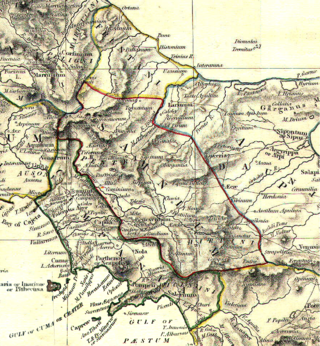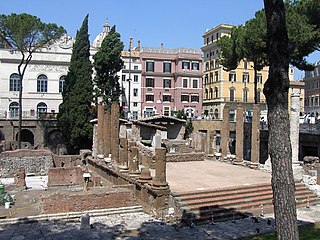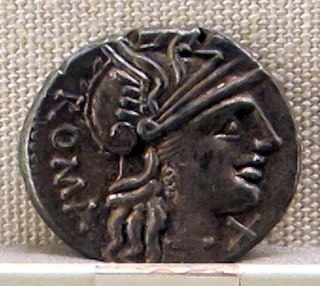Early career
Born of equestrian rank, Carvilius served as curule aedile in 299 BC, and six years later entered upon his first consulship with Lucius Papirius Cursor. They met with great success against the Samnites, with Carvilius taking Amiternum, Cominium, Palumbinum, and Herculaneum. Carvilius was then sent into Etruria, where the Falisci had broken the peace. He took the town of Troilium and five other fortified locations, defeated the Faliscan army, and granted them peace in exchange for a large fine.
Returning to Rome, Carvilius celebrated a triumph, distributed much of the booty he had captured to his soldiers, paid 380,000 pounds of bronze into the treasury, and used the remainder to pay for the erection of a temple to Fors Fortuna. Using bronze armor taken from the Samnites, he had a colossal statue of Jupiter built on the Capitol, which was said to be so tall that it could be seen from the temple on the Alban Mount. According to legend, enough bronze fell from the statue during its polishing, that Carvilius had a statue of himself cast from it and placed at the feet of the colossus. [1] [2] [3] [4]
The following year, Carvilius was appointed Legatus to the consul Decimus Junius Brutus, who had no military experience. The historian Marcus Velleius Paterculus also states that Carvilius held the office of censor, probably in 289 BC. [5] [6]
During the 290s BC, Hellenistic civilization begins its emergence throughout the successor states of the former Argead Macedonian Empire of Alexander the Great, resulting in the diffusion of Greek culture throughout the Levant and advances in science, mathematics, philosophy, etc. Meanwhile, the Roman Republic is embroiled in war against the Samnites, the Mauryan Empire continues to thrive in Ancient India, and the Kingdom of Qin in Ancient China, the one which in the future will conquer its adversaries and unite China, begins to emerge as a significant power during the Warring States period.
Year 293 BC was a year of the pre-Julian Roman calendar. At the time it was known as the Year of the Consulship of Cursor and Maximus. The denomination 293 BC for this year has been used since the early medieval period, when the Anno Domini calendar era became the prevalent method in Europe for naming years.

The gens Mamilia was a plebeian family at ancient Rome during the period of the Republic. The gens was originally one of the most distinguished families of Tusculum, and indeed in the whole of Latium. It is first mentioned in the time of the Tarquins; and it was to a member of this family, Octavius Mamilius, that Lucius Tarquinius Superbus, the seventh and last King of Rome, betrothed his daughter. The gens obtained Roman citizenship in the 5th century BC, and some of its members must subsequently have settled at Rome, where Lucius Mamilius Vitulus became the first of the family to hold the consulship in 265 BC, the year before the First Punic War.
The gens Pontia was a plebeian family at ancient Rome. Few members of this gens rose to prominence in the time of the Republic, but the Pontii flourished under the Empire, eventually attaining the consulship. Pontius Pilatus, as prefect of Judaea, is known for his role in the execution of Jesus.
The gens Papiria was a patrician family at ancient Rome. According to tradition, the Papirii had already achieved prominence in the time of the kings, and the first Rex Sacrorum and Pontifex Maximus of the Republic were members of this gens. Lucius Papirius Mugillanus was the first of the Papirii to obtain the consulship in 444 BC. The patrician members of the family regularly occupied the highest offices of the Roman state down to the time of the Punic Wars. Their most famous member was Lucius Papirius Cursor, five times consul between 326 and 313 BC, who earned three triumphs during the Samnite Wars. Most of the Papirii who held office under the later Republic belonged to various plebeian branches of the family. Although the most illustrious Papirii flourished in the time of the Republic, a number of the family continued to hold high office during the first two centuries of the Empire.

Lucius Papirius Cursor was a celebrated politician and general of the early Roman Republic, who was five times consul, three times magister equitum, and twice dictator. He was the most important Roman commander during the Second Samnite War, during which he received three triumphs.

The Battle of Aquilonia, was fought between the Roman Republic and the Samnites during the Third Samnite War in 293 BC, this battle saw a large Samnite army that had gathered in the mountainous region of Aquilonia to stop Roman expansion but was decisively defeated by the Roman legionaries led by Consul Lucius Papirius Cursor and Consul Spurius Carvilius

The gens Lutatia, occasionally written Luctatia, was a plebeian family of ancient Rome. The first of the gens to obtain the consulship was Gaius Lutatius Catulus in 242 BC, the final year of the First Punic War. Orosius mentions their burial place, the sepulchrum Lutatiorum, which lay beyond the Tiber.

The gens Minucia was an ancient Roman family, which flourished from the earliest days of the Republic until imperial times. The gens was apparently of patrician origin, but was better known by its plebeian branches. The first of the Minucii to hold the consulship was Marcus Minucius Augurinus, elected consul in 497 BC.

The gens Postumia was a noble patrician family at ancient Rome. Throughout the history of the Republic, the Postumii frequently occupied the chief magistracies of the Roman state, beginning with Publius Postumius Tubertus, consul in 505 BC, the fifth year of the Republic. Although like much of the old Roman aristocracy, the Postumii faded for a time into obscurity under the Empire, individuals bearing the name of Postumius again filled a number of important offices from the second century AD to the end of the Western Empire.
The gens Carvilia was a plebeian family at ancient Rome, which first distinguished itself during the Samnite Wars. The first member of this gens to achieve the consulship was Spurius Carvilius Maximus, in 293 BC.
Spurius Carvilius Maximus Ruga was Roman consul in 234 and 228 BC. Spurius Carvilius Ruga, the schoolteacher, was his freedman.

The gens Caedicia was a plebeian family at ancient Rome. Members of this gens first came to prominence in the early decades of the Republic, but none obtained the consulship until Quintus Caedicius Noctua in 289 BC. The family faded from public life during the later Republic, but one of the Caedicii was known to Juvenal, toward the end of the first century AD.
Caeso Fabius Vibulanus was consul of the Roman republic in 484, 481, and 479 BC. He had earlier held the office of quaestor parricidii in 485 BC in connection with the trial and execution of Spurius Cassius Vecellinus.
The gens Laelia was a plebeian family at Rome. The first of the gens to obtain the consulship was Gaius Laelius in 190 BC.
The gens Maelia was a plebeian family at ancient Rome. Members of this gens are mentioned in the time of the early Republic, from just after the decemvirs down to the Samnite Wars. The Maelii belonged to the equestrian order, and were among the wealthiest of the plebeians. The most famous of the Maelii was probably Spurius Maelius, a wealthy merchant who purchased grain from the Etruscans during a famine in 440 BC, and sold it to the poor at a nominal price. The following year, the patricians accused him of conspiring to make himself king, and when he resisted arrest he was slain by the magister equitum, Gaius Servilius Ahala.
The gens Mummia was a plebeian family at Rome. Members of this gens are first mentioned after the Second Punic War, and within a generation, Lucius Mummius Achaicus became the first of the family to obtain the consulship. Although they were never numerous, Mummii continued to fill the highest offices of the state through the third century AD.
The gens Nautia was an old patrician family at ancient Rome. The first of the gens to obtain the consulship was Spurius Nautius Rutilus in 488 BC, and from then until the Samnite Wars the Nautii regularly filled the highest offices of the Roman Republic. After that time, the Nautii all but disappear from the record, appearing only in a handful of inscriptions, mostly from Rome and Latium. A few Nautii occur in imperial times, including a number who appear to have been freedmen, and in the provinces.
The gens Publilia, sometimes written Poblilia, was a plebeian family at ancient Rome. Members of this gens are first mentioned in the early decades of the Republic. The lex Publilia passed by Volero Publilius, tribune of the plebs in 471 BC, was an important milestone in the struggle between the patrician and plebeian orders. Although the Publilii appear throughout the history of the Republic, the family faded into obscurity around the time of the Samnite Wars, and never again achieved positions of prominence in the Roman state.
The Battle of Imbrinium was fought in 325 BC during the Second Samnite War between the Roman Republic, led by the magister equitum, Quintus Fabius Maximus Rullianus and the Samnites near Imbrinium, a city in Samnium.
![]() This article incorporates text from a publication now in the public domain : Smith, William, ed. (1870). Dictionary of Greek and Roman Biography and Mythology .
This article incorporates text from a publication now in the public domain : Smith, William, ed. (1870). Dictionary of Greek and Roman Biography and Mythology .





